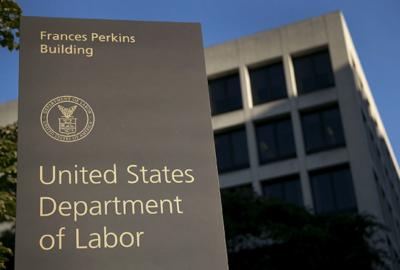

Maylin Jue, the Labor Department’s enterprisewide shared services program manager, said by consolidating human resources, personnel security, technology and...
The same is true for procurement and personnel security services.
These three back-office areas are the first of several to come under a new enterprisewide consolidation initiative.
Maylin Jue, the Labor Department’s enterprisewide shared services program manager, said this agencywide effort isn’t just about consolidation, but making back office or administrative support services better, faster and cheaper.

“We have stood up a new centralized office of human resources. We transitioned all HR staff from across the department into one new office. This allows us to have more team building, training and customer outreach, and it allows us to optimize business processes,” Jue said in an interview with Federal News Network. “We have seen improvement in the consistency of the services and making sure everyone is following the same policies across the department. We’ve gotten a lot of compliments from a lot of the agency about improvements in staffing, which is a huge win for the department to hire more effectively and efficiently.”
While the HR consolidation is furthest along, Labor’s end goal is to reduce costs and improve efficiencies and consistency across all administrative functions.
“Once transitions are complete, employees across the department will experience improved service delivery from their HR, IT, procurement and personnel security service providers. Service will be more consistent across the department, as it will all fall under one service provider that utilizes standard policies and procedures. Service will be compliant with federal regulations and will strive to meet industry best practices in both the public and private sectors,” Jue said. “Creating centralized offices for administrative services will also allow more opportunities for innovation within the department. By improving IT functionality, providing more user friendly HR services, improving procurement efficiency and streamlining personnel security processing, DOL employees will be able to focus more on their mission rather than being burdened by administrative tasks. Lastly, the employees of the service providers will have opportunities to work with a broader portfolio of clients on a variety of challenging projects, receive consistent professional development and training and seek improved advancement within their professional field.”
Labor started this back-office consolidation initiative in 2017 with a focus on human resources and soon expanded it to the other areas. Procurement, IT and personnel security now are all well on their way to meeting Labor’s goals of agility to meet new requirements from customers and cost savings.
Jue said the first part of the effort was about collecting feedback from users through focus groups that included employees up and down the chain. She said the idea was to understand any and all concerns and business processes, and begin to establish baseline metrics.
“Before shared services, a lot of agencies were not necessarily measuring their service levels within their HR or procurement offices. So as part of this, we worked on service level agreements for each area,” she said “Time to hire is a good example. We are measuring the components that the HR office is responsible for because there are shared responsibilities when it comes to time to hire.”
For IT, metrics included network up time, response rates for help desks tickets and other support services. Under procurement, the metrics include processing of task orders, new procurements and modifications to current contracts.
Jue said the governance boards establish the service level agreements (SLAs) for each administrative function based on customer expectations. She said each administrative function also will depend on client engagement managers who serve as the intermediary between the provider organization and the client offices.
“These liaisons will discuss business needs directly with customers and facilitate service delivery that meets the standards set in the SLAs,” Jue said. “Following a six-month baseline period to calibrate the SLA performance measurements, the SLAs will be reported quarterly to client agencies and linked to senior leadership as part of the annual review process.”
Jue said a governance board oversees each of these administrative areas, and Labor is creating an overarching enterprisewide governance board to consider broader strategies for shared services.
The governance boards are a key piece to the “culture change” puzzle. Implementing shared services within an agency many times is dependent on getting both senior executives and mid-tier managers on board with the concepts and changes.
Agencies like Labor and Commerce have found more success by consolidating functions internally than governmentwide efforts for human resources, financial management and the like.
“Each shared services organization will also have a governing body consisting of functional leadership and rotating client agency representatives to facilitate regular discussion of overall service delivery and departmental needs. These governance boards will typically meet on a bimonthly basis and provide the shared services organizations with real-time feedback,” Jue said. “Additionally, client agencies will have the opportunity to provide input into the semi-annual performance reviews of senior leaders of each HR, IT, procurement, and personnel security shared services organization. Adding customer input into the performance appraisals incentivizes the leadership to provide high quality service.”
Some of the reasons why Labor is finding success with this enterprisewide shared services approach are these governance boards, the SLAs and the broad input from customers. Jue said her office also will conduct a customer satisfaction survey in fiscal 2021.
She said most of these factors were not part of previous shared services efforts.
“You have to engage with all stakeholders, understand their concerns, their needs and their uniqueness,” Jue said. “You also have to look at how you can institute accountability. We did that through performance tracking and the governance board. The agencies need to have input after things are consolidated. You have to think about this as a customer service. At the end of the day, we are delivering services to other parts of Labor and we can’t do it well if we don’t understand what they need.”
Copyright © 2025 Federal News Network. All rights reserved. This website is not intended for users located within the European Economic Area.
Jason Miller is executive editor of Federal News Network and directs news coverage on the people, policy and programs of the federal government.
Follow @jmillerWFED

